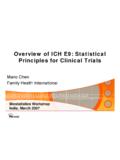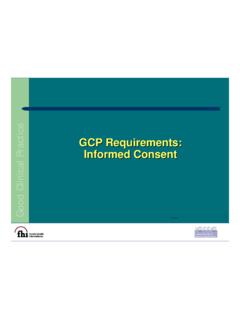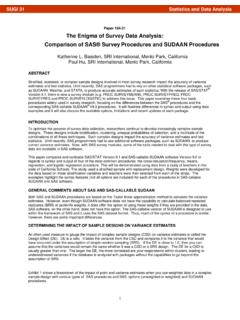Transcription of Introduction to Analysis Methods for Longitudinal ...
1 11 Introduction to Analysis Methods for Longitudinal / clustered Data, Part 3: Generalized Estimating EquationsMark A. Weaver, PhDFamily Health InternationalOffice of AIDS Research, NIHICSSC, FHI Goa, India, September 200922 Objectives1. To develop a basic conceptual understanding of what generalized estimating equation (GEE) Methods are and2. When they might be applicable3. With a focus on interpretation of results33 What are GEE? GEE (Liang and Zeger, 1986) provide a method of inference for a wide variety of models when responses are correlated Linear regression (for continuous outcomes) Logistic regression (for binary outcomes) Poisson regression (for outcomes that are counts) Proportional odds (for ordinal categorical outcomes)44 What are GEE?
2 GEE are an analysismethod, not models in and of themselves You specify a model that you d like to fit using GEE Model is specified through1. A link functionthat relates the mean response to the regression equation link = logit for logistic regression link = log for Poisson regression2. An assumed distributionfor the response, although distributional assumptions not really strong binomial for logistic regression poisson for Poisson regression3. A working correlation matrix(more on this later)55 GEE Benefits GEE provides many of the same benefits as mixed models. Accounts for within-subject/within-cluster correlations Allows for missing data (but requires stronger assumption in this regard than mixed models) Allows for time-varying covariates Allows for irregularly-timed or mistimed measurements Range of correlation structures66 Differences Between GEE and Mixed Models Mixed models can fit multiple levels of correlations Ex.
3 , Longitudinal data from children clustered within schools GEE, as implemented in software, is generally restricted to one level of correlation Mixed models fit subject-specific models GEE fit marginal models (population average). Mixed models require normality assumptions GEE allow for weaker distributional Between GEE and Mixed Models Mixed models require assumption that you have correctly specified the correlation structure GEE do not. GEE provide consistent ( , asymptotically unbiased) parameter and standard error estimates even if you do not pick the correct correlation structure. Requires number of clusters (or subjects in RCT) to be large ( , >50 is probably ok, >100 better) As long as robust standard errors are used, not model-based standard errors However, choosing a correlation structure that is closer to the truth improves efficiency of estimates88 Example Intervention: American Heart Association 8-week School Program (among 3rdand 4thgraders) Is the intervention effective to reduce proportion of kids with high systolic BP?
4 Y =HiBP T = Treatment (0=Control, 1=Intervention) New: 3 study visits1. Visit 1 baseline, pre-randomization2. Visit 2 8 weeks following start of intervention3. Visit 3 1 Year post-intervention99 Long Data Structure Reminder, GEE requires long data structure One record per observation per subject True for all standard statistical Stats30751( )256330746( )261230716 ( )2911 Total10 HiBPVisitT = 0 (Control)25922 ( )237325916 ( )243225912 ( )2471 Total10 HiBPVisitT = 1 (Intervention)No missing data here (unrealistic!), but GEE would have still worked fine even if there had of Interest Primary question: Is intervention effective at reducing proportion with high BP over 8 weeks?
5 1. Re-expressed: Do the groups differ wrt change in proportion with high BP from baseline to post-intervention (V1 to V2), controlling for other important variables?1212 Questions of Interest Secondary questions:2. Do the groups differ wrtchange from baseline to 1 year following intervention (V1 to V3), controlling for other important variables?3. Do the groups differ wrt change from immediately post-intervention to 1 year later (V2 to V3), controlling for other important variables?1313 Review of Logistic Regression Model We ll start by reviewing Mario s model:logit( ) = 0+ 1*T + 2*B_HiBP+ 3*METSUM + 4*B_AGE + 5*MALE + 6*URBAN where = Pr{ HiBP = 1 | T, B_HiBP.}
6 }logit( ) = log[ / (1- ) ] = log odds of high BPodds = exp{ 0+ 1*T + 2*B_HiBP + .. }1414 Longitudinal Logistic Regression Model Now consider adding terms for additional visits:logit( ) = 0+ 1*T + 2*V2 + 3*V3 + 4*T *V2 + 5*T *V3+ 6*METSUM + 7*B_AGE + 8*MALE + 9*URBAN1515 Interpretation of Logistic Parametersexp{ 0+ 1+ 3+ 5}31exp{ 0+ 1+ 2+ 4}21exp{ 0+ 1}11exp{ 0+ 3}30exp{ 0+ 2}20exp{ 0}10 OddsVisitT exp{ 2} is the OR comparing V2 to V1 for T = 0 exp{ 2+ 4} is the OR comparing V2 to V1 for T = 1 exp{ 4} is the ratio of these ORs, which compares change from V1 to V2 for intervention group to that for control1616 Relating Model Parameters to Questions1.
7 Do the groups differ wrt change in proportion with high BP from baseline to post-intervention (V1 to V2)? H0: exp{ 4} =1 H0: 4=0 2.. from V1 to V3?H0: exp{ 5} =1 H0: 5=03.. from V2 to V3?H0: exp{ 5- 4} =1 H0: 5- 4=01717 Where Does GEE Come In? So far, everything we ve talked about has been a review of standard logistic regression So, where does GEE come in? Keep in mind that the goal of GEE is to account for within-subject : Working Correlation Structure In GEE, you choose a working correlation structure: Available choices: compound symmetry (exchangeable), unstructured, few more In a sense, choice doesn t matter in large samples ( , > 100 clusters) because parameter estimates will be unbiased regardless Also provides unbiased estimates of parameters standard errors1919 Let s Fit the Model!
8 Stata: XTGEE commandxtgee dependent var independent vars , i( stid ) link( logit ) family( binomial ) corr( exchangeable ) robust2020 Let s Fit the Model! SPSS: GENLIN command (or use point and click)link=logitdistribution=binomial/ repeated subject=stidcorrtype=exchangeableAnalyze Generalized Linear Models GEE2121 Model with Compound Symmetric Working (Visit 3) (Visit 2) (Visit 1)Col3(Visit 3)Col2(Visit 2)Col1(Visit 1)Working Correlation Matrix2222 Model Parameter * *Vis2<. <. <. > |Z|SEEstimateParameter 0= 1= 2= 3= 4= 5= 6= 7= 8= 9=2323 Answering Our Questions of Interest1. Do the groups differ wrt change in proportion with high BP from baseline to post-intervention (V1 to V2)?
9 Recall: OR comparing V2 to V1 for T=0exp{ 2} = exp{ } = OR comparing V2 to V1 for T=1exp{ 2 + 4 } = exp{ } = Ratio of these two ORs compares change btw groupsexp{ 4 } = exp{ } = Our Questions of ( , )exp{ 5- 4} = V2 to ( , )exp{ 5} = V1 to ( , )exp{ 4} = V1 to V2p-value95% CIEstimated ratio of ORsQuestion2525 Model with Unstructured Working (Visit 3) (Visit 2) (Visit 1)Col3(Visit 3)Col2(Visit 2)Col1(Visit 1)Working Correlation Matrix2626 Answering Our Questions of ( , )exp{ 5- 4} = V2 to ( , )exp{ 5} = V1 to ( , )exp{ 4} = V1 to V2p-value95% CIEstimated ratio of ORsQuestionVirtually identical to those for the model with the compound symmetric working correlation matrix2727 Concluding Remarks For our example, final conclusions did not depend on the chosen working correlation matrix But, sometimes they will!
10 Suggested approach for GEE: prior to Analysis , specify a reasonable form for the working correlation matrix in the Analysis planand stick with it To avoid biasing (or appearance of biasing) results







